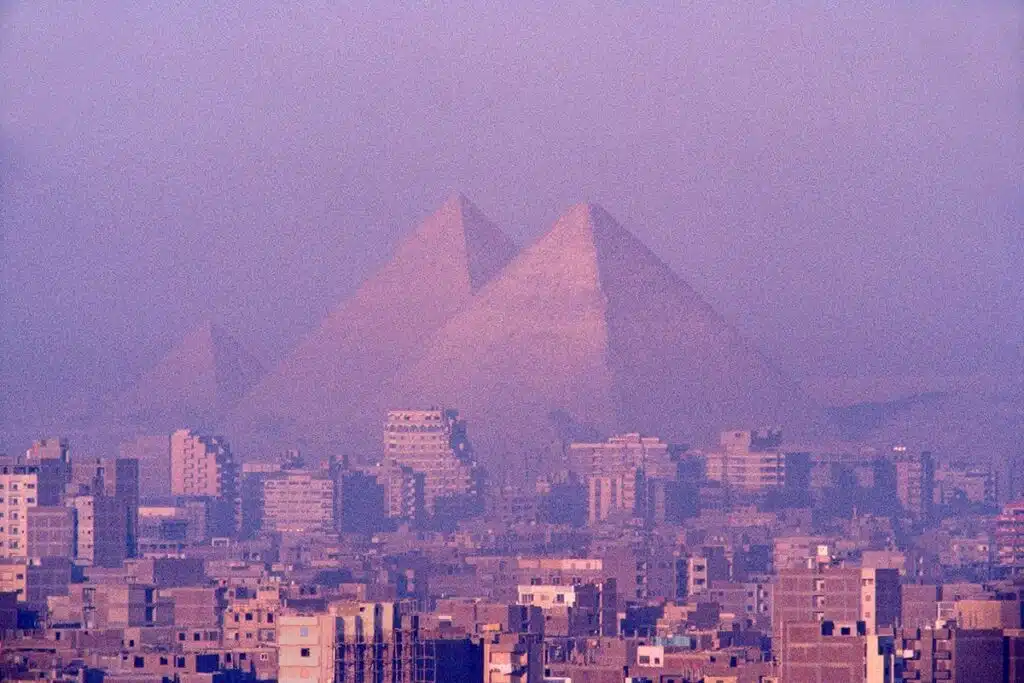Why Visit the Pyramids of Egypt in 2025?
Few places on Earth can rival the awe-inspiring legacy of the Pyramids of Egypt. Rising from the golden sands on the edge of Cairo, the Giza Plateau holds some of humanity’s most remarkable achievements—structures that have stood for more than 4,500 years and still captivate millions of travelers each year.
In 2025, there has never been a better time to explore these wonders. Improved visitor facilities, new archaeological discoveries, and an expanding selection of guided tours make it easier than ever to experience Egypt’s ancient treasures up close. Whether you’re planning your first trip or returning to uncover hidden corners of the pyramids, this comprehensive guide will help you make the most of your journey.
From the colossal Great Pyramid of Khufu to the enigmatic Sphinx, you’ll discover fascinating facts, timeless legends, and practical tips to ensure an unforgettable adventure. We’ll also explore other historical sites in Cairo and share recommendations for nearby hotels and tours to create a complete, hassle-free travel experience.
Get ready to walk in the footsteps of pharaohs, marvel at ancient engineering, and see why the Pyramids of Giza remain one of the world’s most important and mesmerizing destinations.
What’s New at the Giza Plateau? Modern Facilities and Renovations
Visiting the Pyramids of Giza in 2025 is a completely different experience compared to just a few years ago. To improve the visitor journey, the Egyptian government has introduced a series of thoughtful renovations and upgrades across the entire plateau.
One of the most significant changes is the removal of all private cars from the area. Today, visitors travel comfortably and efficiently using a modern system of environmentally friendly electric buses. These buses shuttle guests between the Grand Gateway, the Pyramids, and the Sphinx, reducing congestion and preserving the serenity of the site.
A striking Grand Gateway has been built about a mile and a half from the Pyramids. Here, you can purchase tickets and explore an elegant exhibition hall before boarding the electric buses to begin your tour.
The Visitor Center has also undergone major improvements, offering a range of ticket purchasing options, from convenient self-service machines to traditional counters. New signposts help guide you around the plateau, making it easier to identify key landmarks, including the Great Pyramid of Khufu and the Pyramid of Khafre.
Additional upgrades include modern, clean restrooms, official souvenir shops, and cafes and restaurants, such as the Khufu Restaurant, which serves delicious Egyptian cuisine in a comfortable setting overlooking the desert.
Interestingly, a controversial plan to reinstall the ancient granite cladding on the Pyramid of Menkaure was recently canceled after public debate, ensuring the site remains true to its original appearance.
These renovations are designed to protect Egypt’s heritage while giving visitors a world-class experience—a thoughtful balance of preservation and modern convenience.
Explore Our Packages Now & Enjoy Your Visit to Cairo and Giza Pyramids
The Timeless Wonder: The Great Pyramid of Khufu
Standing taller than any other structure on the Giza Plateau, the Great Pyramid of Khufu—also called the Pyramid of Cheops—is the last surviving wonder of the ancient world. For more than 4,500 years, this colossal monument has fascinated historians, archaeologists, and travelers alike.
Rising originally to a height of about 146 meters (481 feet), it remained the tallest man-made structure on Earth for millennia. Even today, after centuries of erosion and the removal of its smooth white casing stones, it towers over the plateau at around 138 meters (453 feet).
The Great Pyramid was built as a tomb for Pharaoh Khufu, who ruled Egypt’s Old Kingdom during the Fourth Dynasty. Historians believe that construction took at least 20 years and required the labor of thousands of skilled workers, engineers, and artisans.
Inside, visitors can explore a network of narrow passages and chambers. The most famous is the King’s Chamber, reached by climbing a steep, ascending corridor known as the Grand Gallery. This remarkable space was constructed from massive granite blocks brought all the way from Aswan, more than 800 kilometers to the south.
Despite centuries of study, many questions remain unanswered. How exactly were the massive limestone and granite blocks transported and lifted into place? What hidden secrets could still be sealed behind the pyramid’s walls?
Recent discoveries have only deepened the mystery. Using advanced scanning technology, archaeologists have detected previously unknown voids and cavities within the pyramid, sparking new theories about its construction and purpose.
Standing before Khufu’s monument, it’s easy to feel a sense of wonder that transcends time. The Great Pyramid remains not just a symbol of ancient Egypt’s engineering genius but also a timeless invitation to explore, question, and dream.
Exploring the Giza Plateau: Khafre and Menkaure Pyramids
While the Great Pyramid of Khufu dominates the skyline, the nearby Pyramids of Khafre and Menkaure complete the iconic trio on the Giza Plateau. These pyramids show how royal architecture evolved and help visitors better understand how ancient Egyptians honored their pharaohs.
The Pyramid of Khafre, built for Khufu’s son, is the second-largest. It appears even taller because it stands on higher ground. It rises to about 136 meters (446 feet) and still displays a cap of original white limestone casing at the top. This rare feature lets us glimpse how all three pyramids once gleamed in the desert sun.
Next to Khafre’s pyramid, you will see the Great Sphinx, carved from a single limestone ridge. Many believe it shows Khafre’s face, combining a lion’s body and a human head. This form symbolizes strength and royal power.
The Pyramid of Menkaure, the smallest of the three, stands at 65 meters (213 feet). Builders completed it toward the end of the Fourth Dynasty. Its lower layers feature polished granite from Aswan, which adds a striking contrast. Though smaller, its design remains highly sophisticated.
Around these pyramids, you can explore funerary temples, causeways, and smaller queens’ pyramids. These structures reveal the complex spiritual beliefs of the time. Each building played a role in guiding the pharaoh’s soul to the afterlife.
Visiting Khafre and Menkaure’s pyramids lets you walk in the footsteps of ancient royalty. You can see the variety and progress in pyramid construction during Egypt’s golden age.
Meet the Sphinx
The Great Sphinx of Giza stands as one of Egypt’s most iconic and mysterious landmarks. It stretches 73 meters long and rises 20 meters high. Carved from natural limestone, it sits beside the Pyramid of Khafre and combines a lion’s body with a human face—most likely representing Pharaoh Khafre.
The Sphinx faces the east, directly toward the rising sun. This positioning led many to believe it carried deep symbolic and religious meaning. Ancient Egyptians likely saw it as a guardian, protecting the sacred tombs of the Giza Plateau.
The statue has endured heavy erosion and damage. Its nose disappeared centuries ago. Some blame Napoleon’s soldiers or early religious fanatics, though older records confirm it was gone even before that. Still, its calm and powerful expression continues to captivate people worldwide.
Between the paws, you’ll find the Dream Stele, placed by Thutmose IV. According to the inscription, the prince fell asleep in the Sphinx’s shadow. In a dream, it promised him the throne if he cleared away the sand. He followed the vision, became pharaoh, and left this stone to tell the story.
Today, conservation teams work regularly to protect the Sphinx. Visitors can walk along secure paths to view and photograph it—often with the pyramids as a majestic backdrop.
With its silent gaze and ancient mystery, the Sphinx still inspires wonder. No visit to Giza feels complete without standing before it and imagining the lives of the people who built it.
Explore Our Packages Now & Enjoy Your Visit to Cairo and Giza Pyramids
What’s Inside the Pyramids?
From the outside, the Pyramids of Giza look like colossal geometric masterpieces. But inside these monuments, explorers and historians have found mysteries that still fascinate the world. The interiors—especially of Khufu’s Great Pyramid—lead you through narrow corridors, steep climbs, and silent chambers once used for royal and religious purposes.
️ Inside the Great Pyramid of Khufu
Unlike tombs in the Valley of the Kings, the Great Pyramid does not display painted walls or golden treasures. Its intrigue comes from its precise structure, complex layout, and hidden chambers.
Visitors enter through a sloping corridor into passageways that rise deep into the pyramid. The main path takes you to the Grand Gallery, an impressive space stretching 47 meters long and over 8 meters high, lined with huge limestone blocks.
At the end sits the King’s Chamber, built from red granite. Inside, you’ll see a simple but striking sarcophagus. Experts believe it held Pharaoh Khufu’s remains. Above it, five hidden “relieving chambers” help keep the ceiling from collapsing under the weight above.
The Queen’s Chamber, set lower, remains a mystery. Despite its name, it likely did not hold a queen. Many think it had a symbolic or ritual purpose.
In 2017, researchers using muon scans detected a large void above the Grand Gallery. This space could be a hidden chamber no one has entered. Its role and contents remain unknown.
️ Inside the Pyramid of Khafre
Khafre’s Pyramid has a simpler interior. A corridor slopes down to a chamber cut from bedrock. A massive granite sarcophagus still rests inside, though no mummy was found. The undecorated space adds to the mystery of its purpose.
️ Inside the Pyramid of Menkaure
Menkaure’s Pyramid, the smallest, has three chambers on different levels. One once held carved panels that were destroyed by fire in the 1800s. A basalt sarcophagus discovered there was sent to England but later lost at sea.
Walking inside the pyramids feels like entering darkness, silence, and wonder. The narrow tunnels and plain walls create a sacred mood. These spaces were not just tombs but designed as spiritual gateways for the pharaoh’s soul.
Today, only a few visitors can go inside at a time to help preserve them. For those who do, it feels like a rare link to Egypt’s ancient builders.
To Discover What’s Inside The Pyramids, Just Click This Button
How Were the Pyramids Built?
No question about Egypt’s pyramids has caused more debate than how they were built. The Great Pyramid alone holds over 2 million limestone and granite blocks, some weighing up to 80 tons. Despite centuries of study, many details still remain unclear. However, modern archaeology has revealed valuable clues about the tools, techniques, and workforce.
️ Materials and Quarrying
Most limestone came from quarries on the Giza Plateau. Workers cut the blocks with copper chisels, dolerite hammers, and wooden sledges. For the King’s Chamber, builders brought huge granite beams from Aswan, almost 500 miles south.
Transport and Placement
Moving the stones demanded creativity and teamwork. Crews likely dragged blocks over causeways with sledges, ropes, and rollers. New evidence shows workers poured water on the sand in front of sledges to reduce friction. Once near the pyramid, teams raised the blocks with ramps. Experts still debate how the ramps looked. Some think ramps were straight; others believe they spiraled around the pyramid as it grew.
The Workforce
The myth of slave labor has been largely disproven. Excavations uncovered workers’ villages with bakeries, workshops, and medical areas. Skilled crews worked in shifts and probably felt proud to serve the pharaoh. These people were craftsmen, engineers, and laborers who built history stone by stone.
️ The Legacy
Even with modern technology, the pyramids’ precision still amazes researchers. Builders placed each block with great care. The structures align almost perfectly with the cardinal points. For many, the pyramids stand as the greatest example of ancient Egyptian engineering and ambition.
Other Historical Sites in Cairo
While the Pyramids of Giza are Egypt’s most famous landmarks, Cairo has many other remarkable historical sites to explore. If you have extra time, consider visiting these places to experience more of Egypt’s rich culture.
The Egyptian Museum
Located in Tahrir Square, the Egyptian Museum holds the world’s largest collection of ancient Egyptian artifacts. You’ll see the treasures of Tutankhamun, giant statues of pharaohs, and preserved mummies. In 2025, some pieces will move to the Grand Egyptian Museum, but the Tahrir building remains essential for history lovers.
Islamic Cairo
The district called Islamic Cairo offers mosques, madrasas, and medieval architecture. Walk through the Citadel of Saladin, where the Mosque of Muhammad Ali dominates the skyline. Afterward, browse Khan El Khalili, a historic market filled with spices, jewelry, and local crafts.
Coptic Cairo
Coptic Cairo shows the city’s Christian roots. You can explore the Hanging Church, one of Egypt’s oldest, built above a Roman fortress. Nearby, the Coptic Museum displays early Christian art and manuscripts. The Ben Ezra Synagogue adds another layer to this area’s diverse past.
️ Saqqara and Dahshur
South of Giza, Saqqara and Dahshur reveal Egypt’s oldest pyramids. In Saqqara, visit the Step Pyramid of Djoser, the first large stone monument. Dahshur features the Bent Pyramid and the Red Pyramid, both built by Pharaoh Sneferu. These sites often have fewer tourists and give you a deeper look at how pyramids developed.
Adding some of these places to your trip will help you see Cairo as a crossroads of civilizations and religions.
Planning Your Visit and New 2025 Renovations
Visiting the Pyramids of Giza has never been easier or more comfortable. Recent renovations now make the experience smoother for travelers. From eco-friendly buses to modern amenities, you can enjoy ancient wonders with better access.
Car Removal and Electric Buses
In 2025, the site removed cars from the Giza Plateau to cut pollution and reduce traffic. Visitors now ride electric buses that shuttle between the entrance, the Sphinx, and each pyramid. This change protects the monuments and makes getting around simple.
️ New Grand Gateway and Visitor Center
A new Grand Gateway sits about a mile and a half from the pyramids. Here, you can buy tickets, explore an elegant exhibition hall, and board the shuttle buses. The Visitor Center includes electronic kiosks with maps and information.
️ Modern Facilities
Clean restrooms, cafes, and official gift shops now welcome guests. The Khufu Restaurant serves traditional Egyptian dishes with views of the pyramids.
️ Signage and Guidance
New signs guide travelers around the plateau. You can find each pyramid and major landmark easily. These updates help visitors feel confident while exploring.
Restoration Plan Cancelled
Experts raised concerns about reinstalling granite cladding on the Pyramid of Menkaure. The project was canceled, so the pyramid remains in its original state.
When you plan your visit, try to arrive early to avoid crowds and heat. You can buy tickets online or at the entrance. Plan at least half a day for the main sites or longer if you want to see everything in detail.
FAQ
Here are clear answers to common questions about visiting the Pyramids of Giza:
Can I go inside the pyramids?
Yes. You can enter the Great Pyramid of Khufu, plus the pyramids of Khafre and Menkaure. Each one requires a separate ticket besides your main site pass. Access sometimes rotates to help protect the interiors.
How old are the pyramids?
Builders completed them during the Fourth Dynasty, around 2600–2500 BCE. They are over 4,500 years old.
Who built the pyramids?
Skilled Egyptian workers, not slaves, constructed them. Excavations found worker villages with bakeries, workshops, and even clinics.
Is the Sphinx older than the pyramids?
Most scholars think the Sphinx was carved during Khafre’s reign, about 2500 BCE, so it is the same age. A few theories claim it is older, but no proof exists.
How much do tickets cost?
In 2025, general entry costs about 400–500 EGP. The Great Pyramid requires an extra 600 EGP ticket. Students with valid IDs often get discounts.
What should I wear?
Wear light, modest clothes and good walking shoes. Bring a hat, sunscreen, and sunglasses if you visit in hot months.
Can I take photos?
Yes. You can photograph the pyramids and Sphinx outside. Inside, photography is usually not allowed unless you get a special permit.
Are there facilities nearby?
Yes. Clean restrooms, cafes, restaurants, and official gift shops are now part of the site. Renovations added many new options.
How much time should I plan for the visit?
Plan at least half a day to see the highlights. If you want to explore more, a full day is ideal.
If You Decide to Visit the Pyramids, Don’t Miss Our Latest Offers







[…] famous landmarks in Egypt begin with the Giza Plateau, but broaden to Cairo tourist places like the Citadel of Saladin, Al-Azhar Mosque, and the labyrinthine Khan El-Khalili bazaar. Hop 25 km […]
You are right, the Saladin Citadel, walking in Khan El Khalili, visiting Al-Azhar Mosque, Al-Azhar Park, and Baron Palace. There are many beautiful archaeological sites in Egypt.